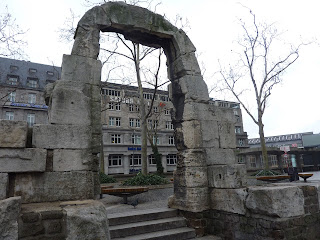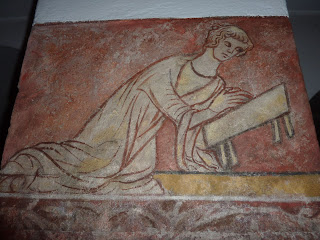25. 01. 2012
Here I am back on the train again. This time the destination is Munich. We are pulling out of the Nürnberg station as I type. Next stop Munich in an hour. Bob is on another train somewhere out there. The travel agency used by the bank did his tickets; then I purchased mine on the same trains. Except for this ticket. I could not find his train on the Deutschebahn schedule. When I queried him, he queried them, and they said the time and number of his train had been “changed” by DB since his tickets were booked. Sounded fishy to me. And sure enough while we were standing on the platform, we discovered there were in fact two trains to Munich leaving four minutes apart. I think I got the better train since I arrive 20 minutes before he does.
Last night was spent in Frankfurt, leaving me with most of a day on my own here. With no particular plans I headed towards the Goethe House Museum. The street map indicated a winding greenway connecting the New Opera House and the Old Opera House that would lead me eventually to the city centre. The walk was kept interesting by some public sculpture.
 |
| Where there is a Goethe, there is always a Schiller |
 |
| These ladies looked uncomfortable without their bathwater |
 |
| Not a clue what it means, but very eye catching |
Frankfurt's Old Opera was destroyed in a bombing raid. A New Opera was built in the early 1950s, and the Old Opera was left as a ruin until the 1960s when plans were made to raze what was left for an office development. The citizens rallied, raised funds, and an exact replica of the beloved Old Opera opened in 1981.
The Goethe House Museum proved to be a wonderful treat that kept me occupied for hours. Four floors of beautifully appointed rooms, filled with interesting objects and art. Visitors are allowed to walk around on their own at their own pace, so no annoying tours and very few ropes to get in the way.
The exhibit about Goethe and his family is very well done, and in English along with German.
 |
| The house was originally a medieval half-timbered structure, but Papa Johann used some of his inheritance to update to a modern style |
Goethe was born in the house in 1749 and looks to have had an ideal childhood immersed in the social and cultural life of the city. His paternal grandfather had made a fortune by marrying a widow with a brewery. Papa Johann lived off his parents' money in this fantastically beautiful house and occupied his time buying paintings from local artists and collecting books. He had the good sense to marry a daughter from one of the town’s leading families, thus acquiring social standing to add to the lustre of inherited wealth.
 |
| The back entrance used to enter the house |
The lovely puppet theatre little Johann received when he was 4 years old is on display and between dreaming up plays for his puppets and reading his father’s science book collection, his career path was established early. Papa Johann however wanted his son to become a working lawyer, but whenever he was sent off to study the law, he preferred the company of writers, painters, and philosophers, so father-son relations became strained.
 |
| An astronomical clock built by a local craftsman |
 |
| According to the guidebook, the bear falls over when the clock needs rewinding. |
 |
| Papa's Library that held his collection of 2,000 books. |
 |
| The all important puppet theatre |
The general wisdom is that Frankfurt is not very interesting for exploring, but I have had a good time without making much of an effort to investigate what's on offer. I just found a website Frankfurt on Foot that has a great walking tour of the city and a great blog filled with ideas for visitors and expats that I will turn to next time I am in Frankfurt.
I arrived in Munich a few minutes ahead of schedule, but Bob’s train took a different route and arrived 45 minutes later. Fortunately our hotel is right next to the train station, and we were able to have an excellent bite to eat and some local beer in the buzzing bar. I'm so glad to be back in Munich, one of my favourite cities.

.jpg)






































